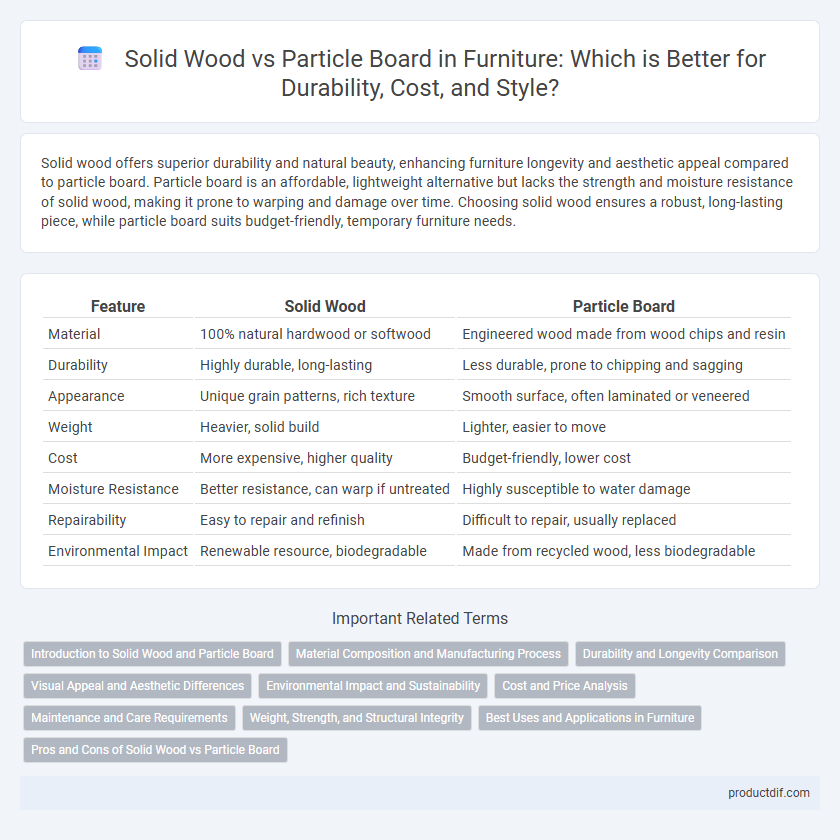Solid wood offers superior durability and natural beauty, enhancing furniture longevity and aesthetic appeal compared to particle board. Particle board is an affordable, lightweight alternative but lacks the strength and moisture resistance of solid wood, making it prone to warping and damage over time. Choosing solid wood ensures a robust, long-lasting piece, while particle board suits budget-friendly, temporary furniture needs.
Table of Comparison
| Feature | Solid Wood | Particle Board |
|---|---|---|
| Material | 100% natural hardwood or softwood | Engineered wood made from wood chips and resin |
| Durability | Highly durable, long-lasting | Less durable, prone to chipping and sagging |
| Appearance | Unique grain patterns, rich texture | Smooth surface, often laminated or veneered |
| Weight | Heavier, solid build | Lighter, easier to move |
| Cost | More expensive, higher quality | Budget-friendly, lower cost |
| Moisture Resistance | Better resistance, can warp if untreated | Highly susceptible to water damage |
| Repairability | Easy to repair and refinish | Difficult to repair, usually replaced |
| Environmental Impact | Renewable resource, biodegradable | Made from recycled wood, less biodegradable |
Introduction to Solid Wood and Particle Board
Solid wood, harvested from natural trees, offers durability, unique grain patterns, and long-lasting strength ideal for high-quality furniture. Particle board, made from compressed wood chips and resin, provides an affordable, lightweight alternative with moderate durability but less resistance to moisture and wear. Choosing between solid wood and particle board depends on budget, usage, and desired furniture longevity.
Material Composition and Manufacturing Process
Solid wood furniture is crafted from natural, singular timber pieces, offering superior strength, durability, and the ability to be refinished multiple times. Particle board consists of wood chips, sawdust, and resin compressed under heat and pressure, resulting in a cost-effective but less durable material prone to swelling and damage from moisture. The manufacturing process of solid wood involves precise cutting and joining of lumber, while particle board relies on engineered fabrication methods, affecting longevity and structural integrity.
Durability and Longevity Comparison
Solid wood furniture offers superior durability and longevity due to its dense, natural fibers that resist wear, dents, and scratches over time. Particle board, made from compressed wood particles and resin, tends to be less durable as it is prone to swelling and cracking when exposed to moisture or heavy use. Investing in solid wood ensures stronger structural integrity and the potential for refinishing, significantly extending the furniture's lifespan compared to particle board alternatives.
Visual Appeal and Aesthetic Differences
Solid wood furniture showcases natural grain patterns and rich textures, offering unique visual appeal with warm, authentic tones that enhance interior aesthetics. Particle board furniture often features a smooth, uniform surface made possible by veneers or laminates, providing a consistent but less organic look compared to solid wood. The tactile depth and natural beauty of solid wood typically elevate the overall style, while particle board prioritizes affordability and versatility in design finishes.
Environmental Impact and Sustainability
Solid wood furniture offers superior environmental benefits due to its durability, biodegradability, and potential for sustainable forestry practices, which reduce deforestation risks. In contrast, particle board production involves adhesive resins and synthetic materials that release volatile organic compounds (VOCs) and generate more waste, impacting indoor air quality and landfill burden negatively. Choosing solid wood supports long-term ecological balance by promoting renewable resources and minimizing chemical pollution.
Cost and Price Analysis
Solid wood furniture commands higher prices due to its durability, natural grain, and long lifespan, often costing two to three times more than particle board alternatives. Particle board offers a budget-friendly option, appealing to cost-conscious consumers with prices typically 40-60% lower but with reduced strength and shorter lifespan. In terms of value for investment, solid wood's initial higher cost is offset by longevity and potential for refinishing, whereas particle board may incur replacement costs more frequently.
Maintenance and Care Requirements
Solid wood furniture demands regular maintenance such as polishing and occasional refinishing to preserve its durability and natural beauty, resisting scratches and dents more effectively over time. Particle board requires more cautious care to prevent moisture damage since it is prone to swelling and warping, often needing protective coatings and immediate cleaning of spills. Choosing solid wood ensures long-term resilience with proper upkeep, while particle board necessitates preventive measures to maintain its structural integrity.
Weight, Strength, and Structural Integrity
Solid wood furniture boasts superior strength and structural integrity due to its dense cellular composition, making it considerably heavier and more durable than particle board. Particle board, composed of compressed wood fibers and resin, is lighter but significantly less sturdy, often leading to a higher risk of warping or sagging under heavy loads. Weight differences reflect these properties, with solid wood furniture offering long-lasting stability ideal for heavy-use items, while particle board suits lighter, budget-friendly applications.
Best Uses and Applications in Furniture
Solid wood is ideal for high-quality furniture pieces requiring durability and long-term strength, such as dining tables, bed frames, and cabinets that benefit from its natural grain and ability to be refinished. Particle board suits budget-friendly furniture, including flat-pack items, shelves, and drawer bottoms, where cost efficiency and lightweight materials are prioritized over structural longevity. Choosing between solid wood and particle board depends on the furniture's intended use, load-bearing needs, and aesthetic preferences.
Pros and Cons of Solid Wood vs Particle Board
Solid wood offers superior durability, natural beauty, and can be refinished multiple times, making it ideal for long-lasting furniture; however, it is more expensive and may be susceptible to warping or cracking due to humidity changes. Particle board is cost-effective, lightweight, and resistant to warping, but it has lower strength, limited lifespan, and is prone to damage from moisture. Choosing between solid wood and particle board depends on budget, intended furniture use, and desired longevity.
Solid wood vs particle board Infographic

 productdif.com
productdif.com